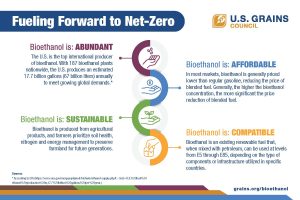U.S. bioethanol is available, affordable, sustainable, and compatible with existing global established infrastructure. Bioethanol’s versatility and productive properties create positive economic, environmental, and health outcomes at home and abroad.

Bioethanol Is Abundant
The United States is the top international producer of bioethanol and is ready and willing to meet foreign market needs. The U.S. Grains Council works with domestic members, partners, and U.S. agencies as well as global stakeholders including agricultural, energy, and transport ministries, agricultural producers, and multilateral organizations to develop markets, fortify local supply chains, and facilitate trade for bioethanol.
With 187 bioethanol plants around the country, the United States produces an estimated 17.7 billion gallons (67.0 billion liters) of bioethanol per year to meet growing global demand.
In the 2022/2023 marketing year, the United States exported 1.25 billion gallons (423 million bushels in corn equivalent).
Bioethanol Is Affordable
Bioethanol is generally priced lower than regular gasoline in most markets, consequently, the addition of bioethanol will reduce the price of blended fuel, benefiting consumers, governments, and the economy with lower energy costs. In most markets, the higher the concentration of bioethanol, the greater the price reduction within blended fuel, providing a cost advantage to refineries, terminals and retail sites. Demand for fossil fuel is relatively inelastic; therefore, substitutes that are low cost and available today, such as bioethanol, are essential to energy pathways forward.
USGC bioethanol market weekly trade report.
U.S. Renewable Fuel Standard Case Study: Quantifying the Benefits of Ethanol to the U.S. Consumer.
U.S. Consumer Savings From Year-Round Nationwide E15 Use.
Refinery Economic Assessment of Ethanol Blending.
Bioethanol Is Sustainable
Farmers focus on soil health, nitrogen management, as well as energy management to protect their farmland for future generations. Agricultural crops are renewable while continuous scientific innovation in over 200 smart climate practices increases their sustainability. State-of-the-art farm equipment, inputs, and monitoring improve yields while mitigating greenhouse gases.
According to a May 2021 study from the United States Department of Energy’s Argonne Laboratory, the carbon intensity of bioethanol is 44-52% lower than gasoline. The carbon intensity of U.S. bioethanol is continually decreasing due to improvements and innovations in farming and bioethanol production. The carbon intensity of corn-based bioethanol in the U.S. declined 23% between 2005 and 2019, resulting in a total GHG reduction of more than 500 million tons. U.S. corn acreage is simultaneously forecasted to continue decreasing. Innovative carbon capture and storage techniques, coupled with greener sources of energy, allow producers to develop a viable path to net zero carbon intensity.
Public health concerns compel governments to mitigate outdoor and indoor air pollution via bioethanol deployment. The World Health Organization recognizes a shift to cleaner fuels outdoors and indoors produces cleaner air, a reduction in particulate matter, and healthier populations. For example, expanding ethanol fuel blending to replace toxic oxygenates such as methyl tertiary-butyl ether (MTBE) as well as petroleum additives such as benzene, toluene, ethylbenzene, and xylene (BTEX) produces cleaner air. Similarly, moving from three stone fires to clean cooking with ethanol can decisively reduce particulate matter concentrations detrimental to human health.
Argonne GREET Model Home Page.
The Carbon Intensity of Corn Ethanol in the United
States.
Bioethanol Is Compatible
Bioethanol, an existing renewable fuel that when mixed with petroleum, is a compatible fuel blend that can be used right here, right now. Direct bioethanol blends can be used in existing vehicle fleets and fuel blending infrastructure at levels from E5 through E85 depending on the type of components or infrastructure utilized within specific countries.
At levels between 3-10%, bioethanol is compatible with all international fleet vehicles while most auto manufacturers explicitly state bioethanol compatibility according to certain bioethanol blend percentages. Compatibility with existing port, refinery, retail and terminal infrastructure such as steel and fiberglass tanks, pump materials, and dispensing systems make bioethanol a strategic advantage for fuel supply chain stakeholders.
Bioethanol is a prudent option to meet global carbon reduction targets. Implementing a low cost, environmentally friendly fuel within current existing infrastructure advances decarbonization of transportation sectors without significant capital costs associated with building out and transitioning vehicle fleet and fuel supply infrastructure.
Ethanol Blended Fuels and Global Vehicle
Compatibility.
E15 Retailer Handbook: Industry Guidelines on Specifications, Procedures and Retail Operations.
